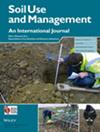Soil erosion alters the composition of soil nitrogen and induces nitrogen immobilization along a sloping agricultural landscape
IF 3.7
3区 农林科学
Q1 SOIL SCIENCE
引用次数: 0
Abstract
Soil erosion transports and redistributes sediment across the landscape, altering soil organic carbon (SOC) and nitrogen (N) availability and stocks. However, the effect of erosion on soil N remains largely unclear. In this study, SOC, soil total N (TN), mineral N ( and ), dissolved organic N (DON) and total dissolved N (TDN) were evaluated in 100‐cm soil profiles in different sites (including the non‐erosion flat site, erosional site and depositional site) to examine the responses of the concentration and composition of soil N to different erosional intensity. Additionally, N mineralization and microbial biomass nitrogen (MBN) were determined to evaluate the bioavailability of soil N. Our results showed that erosion depleted TN in the erosional sites while enriching it in the depositional site throughout the soil profile. The erosion, rather than the deposition, altered the composition of dissolved N, with TDN (DON and mineral N) dominating deeper soil profiles (40–100 cm, accounting for 18%–50% of TN). The wide soil C:N ratio in the erosional site altered microbial metabolism to mine N to maintain their growth rather than mineralizing organic matter into soil bioavailable forms. This was supported by the net N mineralization (N土壤侵蚀改变了土壤氮的组成,并诱发了坡地农业景观的氮固定化
土壤侵蚀会将沉积物输送到地表并重新分配,从而改变土壤有机碳(SOC)和氮(N)的可用性和储量。然而,水土流失对土壤氮的影响在很大程度上仍不清楚。本研究评估了不同地点(包括非侵蚀平坦地点、侵蚀地点和沉积地点)100 厘米土壤剖面中的 SOC、土壤全氮(TN)、矿质氮(和)、溶解有机氮(DON)和总溶解氮(TDN),以研究土壤氮的浓度和组成对不同侵蚀强度的响应。我们的研究结果表明,在整个土壤剖面中,侵蚀造成侵蚀地土壤氮含量减少,而沉积地土壤氮含量增加。侵蚀而非沉积改变了溶解氮的组成,TDN(DON 和矿物氮)在较深的土壤剖面(40-100 厘米,占 TN 的 18%-50%)中占主导地位。侵蚀区土壤中较大的碳氮比改变了微生物的新陈代谢,使其为维持生长而开采氮,而不是将有机物矿化成土壤生物可利用的形式。净氮矿化度(Nm)证实了这一点,它与甲基溴氮和土壤碳氮比呈显著负相关。侵蚀造成的 SOC 和 TN 的不平衡流失导致了土壤氮的限制。总之,我们的研究结果表明,水土流失降低了 TN 的浓度,改变了溶解 N 的组成,导致 N 固定化,降低了土壤生物可利用的 N。
本文章由计算机程序翻译,如有差异,请以英文原文为准。
求助全文
约1分钟内获得全文
求助全文
来源期刊

Soil Use and Management
农林科学-土壤科学
CiteScore
7.70
自引率
13.20%
发文量
78
审稿时长
3 months
期刊介绍:
Soil Use and Management publishes in soil science, earth and environmental science, agricultural science, and engineering fields. The submitted papers should consider the underlying mechanisms governing the natural and anthropogenic processes which affect soil systems, and should inform policy makers and/or practitioners on the sustainable use and management of soil resources. Interdisciplinary studies, e.g. linking soil with climate change, biodiversity, global health, and the UN’s sustainable development goals, with strong novelty, wide implications, and unexpected outcomes are welcomed.
 求助内容:
求助内容: 应助结果提醒方式:
应助结果提醒方式:


